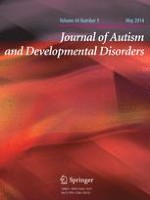01-05-2014 | Original Paper
The Interplay Between Anxiety and Social Functioning in Williams Syndrome
Gepubliceerd in: Journal of Autism and Developmental Disorders | Uitgave 5/2014
Log in om toegang te krijgenAbstract
The developmental disorder Williams syndrome (WS) has been associated with an atypical social profile of hyper-sociability and heightened social sensitivity across the developmental spectrum. In addition, previous research suggests that both children and adults with WS have a predisposition towards anxiety. The current research aimed to explore the profiles of social behaviour and anxiety across a broad age range of individuals with the disorder (n = 59, ages 6–36 years). We used insights from parental reports on two frequently used measures, the Spence Children’s Anxiety Scale (SCAS-P) and the Social Responsiveness Scale (SRS). Severity of anxiety was correlated with a greater degree of social dysfunction as measured by the SRS in this group. We split the group according to high or low anxiety as measured by the SCAS-P and explored the profile of social skills for the two groups. Individuals high and low in anxiety differed in their social abilities. The results emphasise the need to address anxiety issues in this disorder and to consider how components of anxiety might relate to other features of the disorder.
